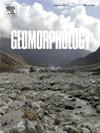Geomorphic imprints of long- and short-term deformation in the Kachchh Intraplate Region (Western India)
IF 3.1
2区 地球科学
Q2 GEOGRAPHY, PHYSICAL
引用次数: 0
Abstract
The Kachchh basin stands out among intraplate regions for having experienced two of the most significant intraplate earthquakes within 200 years: the 1819 Allah Bund earthquake (Mw 7.8) and the 2001 Bhuj earthquake (Mw 7.6). The latter occurred just north of a previously unidentified fault near the region's longest-running fault, i.e., the Kachchh Mainland Fault (KMF). Despite numerous surveys conducted after the 2001 event, no primary rupture was observed along this discontinuity, raising significant questions about the KMF's deformational patterns.
This study aims to decipher regional tectonic perturbations throughout the Northern Hill Range (NHR), focusing on the deformational front associated with the KMF and identifying distinctive geomorphic indicators of active tectonics. The investigation reveals variation in tectonic activity along the KMF, with more pronounced and recent activity on the central-eastern side of the NHR. This line of research culminated in paleoseismic trenching near the epicentral region of the 2001 Bhuj earthquake, identifying a paleo-event bracketed between 3.44 ka and 1.84 ka BP.
印度西部Kachchh板内地区长期和短期变形的地貌印记
Kachchh盆地因在200年内经历了两次最严重的板内地震而在板内地区中脱颖而出:1819年安拉外滩地震(里氏7.8级)和2001年布吉地震(里氏7.6级)。后者发生在该地区运行时间最长的断层,即Kachchh大陆断层(KMF)附近的一个先前未被识别的断层的北部。尽管2001年地震发生后进行了大量的调查,但沿着这一不连续面没有观察到主要破裂,这就提出了有关KMF变形模式的重大问题。本研究旨在破译整个北山(NHR)的区域构造扰动,重点关注与KMF相关的变形锋,并识别活动构造的独特地貌指标。调查揭示了沿KMF的构造活动的变化,在NHR的中东部更明显和最近的活动。这条研究路线在2001年布吉地震震中区域附近的古地震沟中达到高潮,确定了一个介于3.44 ka和1.84 ka BP之间的古事件。
本文章由计算机程序翻译,如有差异,请以英文原文为准。
求助全文
约1分钟内获得全文
求助全文
来源期刊

Geomorphology
地学-地球科学综合
CiteScore
8.00
自引率
10.30%
发文量
309
审稿时长
3.4 months
期刊介绍:
Our journal''s scope includes geomorphic themes of: tectonics and regional structure; glacial processes and landforms; fluvial sequences, Quaternary environmental change and dating; fluvial processes and landforms; mass movement, slopes and periglacial processes; hillslopes and soil erosion; weathering, karst and soils; aeolian processes and landforms, coastal dunes and arid environments; coastal and marine processes, estuaries and lakes; modelling, theoretical and quantitative geomorphology; DEM, GIS and remote sensing methods and applications; hazards, applied and planetary geomorphology; and volcanics.
 求助内容:
求助内容: 应助结果提醒方式:
应助结果提醒方式:


